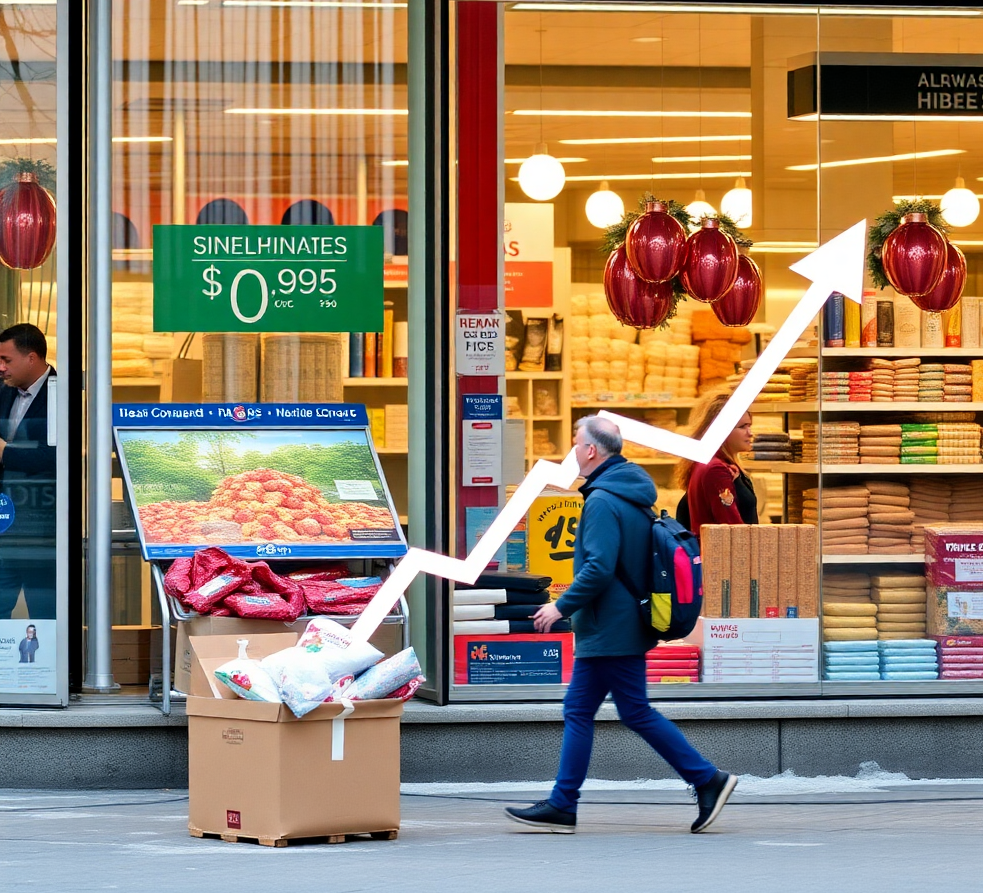
In December 2024, U.S. consumer prices saw an unanticipated rise, challenging expectations of inflation moderation. The Consumer Price Index (CPI) climbed by 0.4%, slightly exceeding the forecasted 0.3%, while annual inflation stood at 2.9%, up from November’s 2.7%. This modest but significant increase highlights persistent economic challenges as policymakers and analysts grapple with inflation trends heading into 2025.
Key drivers of December’s rise included energy costs, which spiked sharply, alongside consistent increases in food and housing prices. These developments emphasize the interconnected nature of inflationary pressures, affecting everything from household budgets to Federal Reserve policies.
This article delves into the details of December’s CPI data, the underlying factors driving the increase, and its broader economic implications. Whether you are a household navigating higher living costs or a business adjusting to rising input prices, understanding these dynamics is crucial for managing the challenges ahead.
Understanding the Consumer Price Index (CPI)
The Consumer Price Index is a crucial economic measure used to track inflation by analyzing price changes for a representative basket of goods and services. The CPI includes diverse categories, such as housing, food, energy, healthcare, and transportation. It provides a snapshot of how prices fluctuate over time, affecting households, businesses, and policymakers.
In December, the CPI highlighted key contributors to inflation. Energy prices emerged as the leading factor, with gasoline costs increasing by 4.4% due to higher seasonal demand and supply chain disruptions. Food prices also rose by 0.3%, driven by costlier fresh produce and grains, reflecting ongoing supply challenges and elevated transportation expenses.
A closer look at the core CPI, which excludes volatile categories like food and energy, reveals a smaller increase of 0.2% for the month. However, the annual core inflation rate remains high at 3.2%. This metric provides a clearer picture of underlying inflation trends, which remain a concern despite signs of moderation in certain sectors.
The CPI’s significance extends beyond data points—it informs critical decisions, such as wage adjustments, cost-of-living increases, and monetary policies. December’s report underscores the complexities of inflation management and its far-reaching effects on economic stability.
What Drove the Rise in Consumer Prices?
1. Energy Prices
Energy costs were a major contributor to December’s inflation, with gasoline prices rising by 4.4%. The spike can be attributed to increased holiday travel demand, seasonal factors, and temporary disruptions in crude oil production. Elevated energy costs ripple across industries, increasing transportation and production expenses for businesses.
Electricity and natural gas costs also climbed, driven by higher heating demands during colder weather. Households faced higher utility bills, adding to the strain on budgets. For businesses, these increases often lead to higher operating costs, some of which are passed on to consumers.
2. Food Prices
Food prices saw a modest 0.3% rise in December, with notable increases in fresh produce, dairy, and grains. These trends reflect continued challenges in agricultural production, labor shortages, and transportation logistics. Higher costs of energy and fuel further exacerbate these issues, impacting every stage of the supply chain.
Lower-income households are particularly affected by rising food costs, as a larger share of their income goes toward essentials like groceries. Many families have been forced to prioritize necessities, foregoing discretionary spending to accommodate higher prices.
3. Housing and Shelter Costs
Housing costs, including rent and homeowners’ equivalent rent, continued their upward trend, remaining a persistent driver of inflation. Shelter prices are among the largest components of the CPI, making their steady rise a significant factor in overall inflation.
Rental costs are rising due to increased demand and limited supply in many markets. For homeowners, higher property maintenance costs and mortgage rates add to financial pressures. The sustained increase in shelter costs highlights the need for targeted housing policies to address affordability challenges.
Broader Impacts of Inflation
Impact on Households
Inflation has far-reaching effects on household budgets, particularly for families already struggling with financial pressures. Essentials such as housing, food, and transportation have experienced the most significant price increases, leaving little room for discretionary spending.
Families are adopting various strategies to manage rising costs, including cutting back on non-essential purchases, shopping for discounts, and choosing generic brands. While these measures provide short-term relief, they underscore the broader challenges inflation poses for economic well-being.
Impact on Businesses
Businesses are also grappling with the consequences of inflation. Rising input costs, driven by higher energy and transportation expenses, have forced many companies to reassess their pricing strategies. Some businesses have passed these costs on to consumers, while others have absorbed them to remain competitive.
Small businesses face unique challenges, as they often lack the resources to weather sustained cost increases. Many are exploring operational efficiencies, renegotiating supplier contracts, and investing in technology to reduce expenses.
Implications for Monetary Policy
The Federal Reserve’s monetary policy plays a critical role in managing inflation. December’s CPI data will likely influence the Fed’s approach in 2025, particularly as it balances the need for price stability with economic growth.
While some analysts expect the Fed to maintain current interest rates in the short term, others predict rate cuts later in the year if inflation continues to show signs of moderation. The central bank’s dual mandate—to achieve maximum employment and stable prices—requires careful calibration to avoid unintended economic consequences.
The Fed’s actions in the coming months will be closely watched by financial markets, businesses, and consumers alike. As policymakers navigate these challenges, the focus will remain on fostering sustainable economic conditions while addressing inflationary pressures.
Coping Strategies for Households
-
Budget Adjustments
Families can navigate rising costs by revisiting their budgets and prioritizing essential expenses. Allocating more funds to necessities like housing and groceries while cutting back on discretionary spending can help manage inflation’s impact. -
Energy Efficiency
Investing in energy-efficient appliances, vehicles, and home improvements can reduce long-term energy costs. Simple measures, such as using programmable thermostats and sealing drafts, can also make a difference. -
Smart Shopping
Consumers can save money by using coupons, shopping sales, and choosing generic brands. Buying in bulk and meal planning can further reduce food costs. -
Financial Planning
Long-term strategies, such as building emergency savings and investing in inflation-protected securities, can help households maintain financial stability during periods of rising prices.
Coping Strategies for Businesses
-
Cost Management
Businesses can mitigate the impact of rising costs by streamlining operations and reducing waste. Conducting regular expense reviews and renegotiating supplier contracts can yield significant savings. -
Dynamic Pricing
Adopting flexible pricing strategies allows businesses to adjust prices in response to changing input costs. Clear communication with customers about these changes can help maintain trust. -
Investment in Technology
Investing in technology, such as automation and data analytics, can improve efficiency and reduce operational costs. These tools enable businesses to adapt more effectively to inflationary pressures. -
Focus on Value
Offering value-driven products and services can help businesses retain customers during periods of rising prices. Emphasizing quality and reliability builds customer loyalty, even when prices increase.
The unexpected rise in December’s consumer prices reflects the ongoing challenges of managing inflation in a dynamic economy. Energy, food, and housing costs were key drivers of this increase, underscoring the interconnected nature of inflationary pressures.
For households and businesses, adapting to these challenges requires proactive strategies, from budget adjustments to operational efficiencies. Policymakers, too, face difficult decisions as they navigate the complexities of inflation and economic growth.
As the Federal Reserve monitors these trends, its decisions in the coming months will shape the economic landscape for 2025 and beyond. Whether you are a consumer or a business leader, staying informed and prepared is essential for navigating the uncertainties ahead.
Feel free to check out our other website at : https://synergypublish.com

